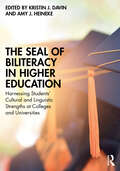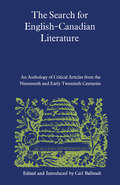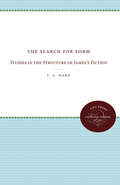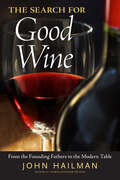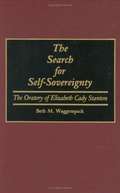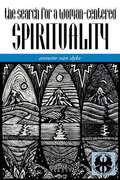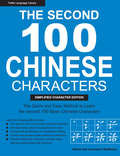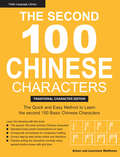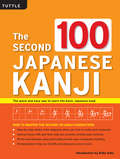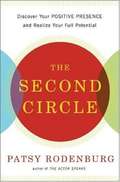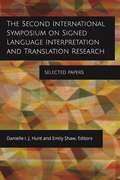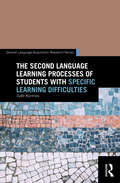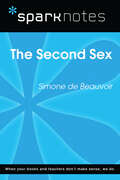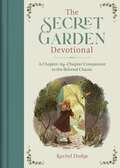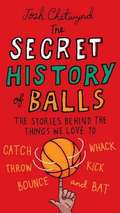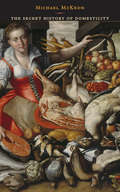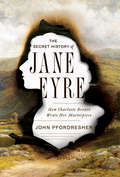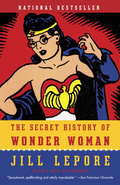- Table View
- List View
The Seal of Biliteracy in Higher Education: Harnessing Students’ Cultural and Linguistic Strengths at Colleges and Universities
by Amy J. Heineke Kristin J. DavinThis book brings together the work of those implementing, using, or researching the Seal of Biliteracy (SoBL) in higher education contexts. Book chapters detail how various institutions of higher education (IHEs) are leveraging their state’s SoBL policy and/or the Global SoBL to promote biliteracy within and across communities. In all 50 United States, high school graduates can earn a state SoBL, which is noted on the high school transcript to certify the ability to read, write, speak, and listen in more than one language. An increasing number of IHEs recognize the SoBL, and evidence suggests that such policies can serve as a recruitment tool, boost enrollment in modern language departments, and facilitate placement into modern language coursework. This book provides examples of how IHEs can implement the state SoBL, the Global SoBL, or their own recognition to recognize students’ multilingualism, boost enrollment, enhance practice, and nurture biliteracy in their communities. The research-based examples in each chapter provide robust examples of how IHEs can leverage the SoBL to increase equity and access to higher education for multilingual students.This book targets educators, leaders, policymakers, and researchers interested in collaborating to enhance multilingualism in their communities. Whether working in K-12 schools or IHEs, readers can learn about potential avenues to expand pipelines, partnerships, and possibilities for learners to earn and benefit from a SoBL.
The Search for English-Canadian Literature
by Carl BallstadtThe search for a distinctive Canadian literature is not new. It began in the 1820s, and even then involved many of the same issues that concern critics today. Much of this early material is now inaccessible to most Canadians. Carl Ballstadt has selected for this volume a number of the most importance statements from a century of growth. The pieces come from essays, prefaces, and editorials published between 1823 and 1926 in a variety of works including the major literary periodicals of the time. Among the authors are Thomas D'Arcy McGee, Sara Jeannette Duncan, Daniel Wilson, Goldwin Smith, G. Mercer Adam, Pelham Edgar, J.D. Robins, J.D. Logan, and Charles Mair. The major themes they treated, with frequent diversity of views, are the kind of writing best suited to a new country; the economic and spiritual barriers to the creation of literature; the feasibility of creating a 'national' literature; the need for serious criticism; the relationship between European traditions and the developing Canadian imagination; Canada's 'northern' character; the advantages of two cultural streams; and the significance of Canadian achievements in poetry. This book provides essential background to anyone concerned with the path Canadian literature followed to modern times.
The Search for Form: Studies in the Structure of James's Fiction
by J. A. WardThis volume is a study of the structure of certain of James's works, as well as a search for the structural principles that inform James's fiction and lie behind the technical dicta of his essays and prefaces. It also develops the thesis that most of James's structures are determined by logical and spatial, rather than chronological, concepts of relationships.Originally published in 1967.A UNC Press Enduring Edition -- UNC Press Enduring Editions use the latest in digital technology to make available again books from our distinguished backlist that were previously out of print. These editions are published unaltered from the original, and are presented in affordable paperback formats, bringing readers both historical and cultural value.
The Search for Good Wine: From the Founding Fathers to the Modern Table
by John HailmanThe Search for Good Wine is a highly entertaining and informative book on all aspects of wine and its consumption by nationally-syndicated wine columnist John Hailman, author of the critically-acclaimed Thomas Jefferson on Wine (2006). Hailman explores the wine-drinking experiences and tastes of famous wine-lovers from jolly Ben Franklin and the surprisingly enthusiastic George Washington to Julius Caesar, Sherlock Holmes, and Ernest Hemingway among numerous other famous figures. Hailman also recounts in fascinating detail the exotic life of the founder of the California wine industry, Hungarian Agoston Haraszthy, who introduced Zinfandel to the U.S.Hailman gives calm and reliable guidance on how to deal with snobby wine waiters and how to choose the best wine books and travel guides. He simplifies the ABCs of wine-grape types from the delicate pinot noirs of Oregon to the robust malbecs of Argentina and from the vibrant new whites of Spain to the great reds (old and new) of Italy. The entire book is dedicated to finding values in wine. As Hailman says, "Everyone always wants to know one basic thing: How can you get the best possible wine for the lowest possible price?" His new book is highly practical and effective in answering that eternal question and many more about wine.A judge at the top international wine competitions for over thirty years, Hailman examines those experiences and the value of "blind" tastings. He gives insightful tips on how to select a good wine store, how to decipher wine labels and wine lists, and even how to extract unruly champagne corks without crippling yourself or others. Hailman simplifies wine jargon and effectively demystifies the culture of wine fascination, restoring the consumption of wine to the natural pleasure it really should be.
The Search for Self-Sovereignty: The Oratory of Elizabeth Cady Stanton
by Beth M. WaggenspackThis book is divided into two major sections. The first is a summary of the life and times of the pioneering women's-rights advocate Elizabeth Cady Stanton with an analysis of several of her most important speeches. The second section reprints some representative speeches in full.
The Search for a Woman-Centered Spirituality
by Annette Van DykeThis work focuses on one of the salient developments of contemporary feminism. Instead of abandoning religious practice altogether as relics of a patriarchal past, large numbers of women have sought to incorporate healing and positive aspects of their spiritual heritage into their lives. Women have also resurrected non-Western traditions and have created alternative rituals, beliefs, and stories to enhance and enlighten our day-to-day existence. This work is a tribute to that creative energy and to the way in which it has enriched feminism for many. The book analyzes themes in several books exemplifying woman-centered spirituality.
The Second 100 Chinese Characters: Simplified Character Edition
by Alison Matthews Laurence MatthewsThis book is a quick and easy way to learn the second 100 basic Chinese characters.All beginning students of Chinese struggle to memorize and learn to write the Chinese characters. The Second 100 Chinese Characters adopts a structural approach which helps students to quickly master the basic characters that are fundamental to this language. Intended for use after The First 100 Characters, this book presents characters that have been carefully selected for rapid and effective learning.The English meanings, pronunciations in Hanyu Pinyin and alternate forms (if any) for each Chinese character are presented along with a stroke order guide and spaces for writing practice. Printed with gray guidelines, the stroke order guides are designed to be traced over to teach students the standard sequence of strokes used to write the character. Related compounds and phrases are given to assist in vocabulary building.This book contains:The second 100 most common Chinese charactersStandard hanyu pinyin romanizations for each characterCompounds and phrases for vocabulary buildingStep-by-step stroke order diagrams show you how to write each characterSpecial boxes with grid lines help yo practice writing them correctlyCompounds and sample sentences provide easy vocabulary building
The Second 100 Chinese Characters: The Quick and Easy Method to Learn the Second 100 Basic Chinese Characters
by Alison Matthews Laurence MatthewsThis book is a quick and easy way to learn the second 100 basic Chinese traditional characters.The major struggle facing all beginning Chinese language students is to learn to recognize, read and write hundreds of Chinese characters. <P><P> The Second 100 Chinese Characters adopts a structural approach that helps students to overcome this initial difficulty and quickly master the basic Chinese characters that are fundamental to this language. Intended for beginning students, this book contains characters that have been carefully selected and sequenced for rapid and effective learning.For effective leaning, memorization and practice, each Chinese character is shown separately on a single page, together with its English definitions, hanyu pinyin romanization, alternate form (if any), a stroke order guide and ample space for writing practice. This book featuresThe second 100 most frequently-used Chinese charactersFoundation characters for the HSK A level language proficiency testStandard hanyu pinyin romanizationsStep-by-step stroke order guides and ample space for writing practiceOver 500 words and phrases containing the basic charactersConcise English definitions
The Second 100 Japanese Kanji: The Quick and Easy Way to Learn Basic Japanese Kanji
by Eriko SatoThis is an invaluable study guide for learning Japanese characters.The major struggle facing all beginning Japanese language students is to learn to recognize, read and write hundreds of Japanese characters.<P><P> The Second 100 Japanese Kanji adopts a structural approach that helps students to overcome the initial difficulty of reading kanji and writing kanji and quickly master the basic Japanese characters that are fundamental to this language. Intended for beginning students, this beginner kanji guide teaches characters that have been carefully selected and sequenced for rapid and effective learning. Each kanji is shown separately on a single page, along with its different readings, its English meanings, romaji (romanization), a stroke-order guide and ample space for writing practice.This book includes: Step-by-step stroke order diagrams for each character. Special boxes with grid lines to practice writing characters. Words and phrases using each kanji. Romanizations (romanji) to help identify and pronounce every word.
The Second Circle: This Book Will Transform Your Life, Minute to Minute
by Patsy RodenburgThe world's leading voice and acting coach provides a revolutionary program to focus your energy and connect with other people. Are you as successful as you could be? Are your good ideas appreciated? Could your sex life be more fulfilling? In this high-paced yet lonely world, Patsy Rodenburg teaches you how to communicate more effectively and intimately--at home, at work, at school, and, most importantly, with yourself. Her remarkable program transforms your negative patterns of energy into a positive presence that she calls "the second circle"--the optimal state between the first circle of introversion and self-negation and the third circle of aggression and narcissism. Containing a wealth of insights that will break the habits that constrict your real power, The Second Circle helps you deal with the debilitating and manipulative behaviors of your immediate family, friends, and colleagues while bringing out their best qualities. Filled with easy-to-apply exercises (breathing, voice, posture), The Second Circle, in dealing with such emotional issues as loss, violation, and self-esteem, will begin a journey that will revitalize your life.
The Second Circle: Using Positive Energy For Success In Every Situation
by Patsy RodenburgThe key to unlocking your power—and the inspired life that comes with it—from the renowned voice and acting coach. You know that person: the one with that certain something. And you’ve probably dismissed that something as unattainable, simply innate. But it’s a myth that some are born with “it” and others aren’t. Everybody can have that presence—and the peaceful self-acceptance that powers it. Patsy Rodenburg reveals that the secret is learning to inhabit “the second circle”: the optimal state between the first circle of introversion and self-doubt and the third of aggression and narcissism. She provides exercises to help you break the habits that constrict your real power and to better cope with the negative behaviors and attitudes of those around you. With wisdom and patience, Rodenburg teaches you how to communicate effectively at home, work, school, and—most important—with yourself. The Second Circle will empower you to meet life’s most extraordinary trials with brio and to embrace the joys and challenges of every single day.
The Second International Symposium on Signed Language Interpretation and Translation Research: Selected Papers (Gallaudet Studies In Interpret #18)
by Emily Shaw Danielle I. J. HuntThe Second International Symposium on Signed Language Interpretation and Translation Research was a rare opportunity for hearing and Deaf students, researchers, educators, and practitioners to come together and learn about current research in Interpretation and Translation Studies. These selected papers are comprised of research conducted in places such as Australia, Flanders, France, and Ghana, creating a volume that is international in scope. Editors Danielle I. J. Hunt and Emily Shaw have collected papers that represent the advances in the depth and diversity of knowledge in the field of signed language interpretation and translation research. Chapter topics include the use of haptic signals when interpreting for Deafblind people, the role of French Deaf translators during the 2015 Paris terror attacks, and Deaf employees’ perspectives on interpreting in the workplace. Signed chapter summaries will be available on the Gallaudet University Press YouTube channel upon publication.
The Second Language Learning Processes of Students with Specific Learning Difficulties (ISSN)
by Judit KormosThe Second Language Learning Processes of Students with Specific Learning Difficulties is the only recent book available to offer a detailed and in-depth discussion of the second language learning processes of students with specific learning difficulties (SpLDs). It summarizes research advances in the fields of cognitive and educational psychology and integrates them with recent studies in the area of second language acquisition (SLA). Thus the book is relevant not only to readers who are particularly interested in the role of specific learning difficulties in learning additional languages, but also to those who would like to understand how individual differences in cognitive functioning influence SLA. The book focuses on four important areas that are particularly relevant for language learners with SpLDs: the processes of SLA in general and the development of reading skills in particular, the effectiveness of pedagogical programs, the assessment of the language competence of students with SpLDs and identifying SpLDs in another language. The book also views learners with SpLDs in their social and educational contexts and elaborates how the barriers in these contexts can affect their language learning processes. This is an excellent resource for language teachers, students, and researchers in the areas of second language acquisition and applied linguistics.
The Second Language Learning Processes of Students with Specific Learning Difficulties (Second Language Acquisition Research Series)
by Judit KormosThe Second Language Learning Processes of Students with Specific Learning Difficulties is the only recent book available to offer a detailed and in-depth discussion of the second language learning processes of students with specific learning difficulties (SpLDs). It summarizes research advances in the fields of cognitive and educational psychology and integrates them with recent studies in the area of second language acquisition (SLA). Thus the book is relevant not only to readers who are particularly interested in the role of specific learning difficulties in learning additional languages, but also to those who would like to understand how individual differences in cognitive functioning influence SLA. The book focuses on four important areas that are particularly relevant for language learners with SpLDs: the processes of SLA in general and the development of reading skills in particular, the effectiveness of pedagogical programs, the assessment of the language competence of students with SpLDs and identifying SpLDs in another language. The book also views learners with SpLDs in their social and educational contexts and elaborates how the barriers in these contexts can affect their language learning processes. This is an excellent resource for language teachers, students, and researchers in the areas of second language acquisition and applied linguistics.
The Second Sex (SparkNotes Literature Guide Series)
by SparkNotesThe Second Sex (SparkNotes Literature Guide) by Simone de Beauvoir Making the reading experience fun! Created by Harvard students for students everywhere, SparkNotes is a new breed of study guide: smarter, better, faster. Geared to what today's students need to know, SparkNotes provides: *Chapter-by-chapter analysis *Explanations of key themes, motifs, and symbols *A review quiz and essay topicsLively and accessible, these guides are perfect for late-night studying and writing papers
The Secret Astronomers
by Jessica WalkerTwo strangers. One forgotten astronomy textbook. A decades-old secret.A fascinating, highly illustrated, epistolary novel perfect for fans of Rainbow Rowell and Alice Oseman!When a recent transfer student starts keeping her diary in the oldest textbook at the Green Bank High School library, the last thing she expects is to receive a response. Thus begins a sweeping tale of unlikely friendship and long-buried secrets between two secret pen pals at a rural West Virginia high school.Copernicus is adrift and searching for answers after the sudden death of her mother, and leaving her cosmopolitan life in San Francisco behind. Kepler is a small-town girl with straight A's and big plans to be the first person in her family to go to college, despite her family's modest means. The two girls are so different from one another but united in their goal to solve a mystery that has riddled Green Bank for decades.Meticulously hand-drawn by debut author Jessica Walker across the pages of an actual ancient astrophsyics textbook, The Secret Astronomers is a story of friendship, family, crop circles, secret crushes, giant telescopes, life in Appalachia, and two girls discovering new ways to connect across any divide that separates them.
The Secret Garden (SparkNotes Literature Guide Series)
by SparkNotesThe Secret Garden (SparkNotes Literature Guide) by Frances Hodgson Burnett Making the reading experience fun! Created by Harvard students for students everywhere, SparkNotes is a new breed of study guide: smarter, better, faster. Geared to what today's students need to know, SparkNotes provides: *Chapter-by-chapter analysis *Explanations of key themes, motifs, and symbols *A review quiz and essay topicsLively and accessible, these guides are perfect for late-night studying and writing papers
The Secret Garden Devotional: A Chapter-By-Chapter Companion to the Beloved Classic
by Rachel DodgeDevotional Inspiration from Mary Lennox's Beautifully Mysterious Secret Garden The Secret Garden Devotional offers lovely inspiration that explores the themes of faith, family, contentment, wisdom, and joy in the classic Frances Hodgson Burnett novel, cherished by generations of readers. Each reading corresponds with a chapter from the book and invites you to embrace God's guiding hand in your life as you are becoming His new creation. With themes of growth, spiritual nourishment, God's love and care, and His transforming power, this beautiful chapter-by-chapter devotional includes original artwork throughout. Each reading includes examples from the novel, scripture, life application, and prayers perfect for groups, book clubs, or personal reflection.
The Secret History
by ProcopiusA trusted member of the Byzantine establishment, Procopius was the Empire's official chronicler, and his History of the Wars of Justinian proclaimed the strength and wisdom of the Emperor's reign. Yet all the while the dutiful scribe was working on a very different - and dangerous - history to be published only once its author was safely in his grave. The Secret History portrays the 'great lawgiver' Justinian as a rampant king of corruption and tyranny, the Empress Theodora as a sorceress and whore, and the brilliant general Belisarius as the pliable dupe of his scheming wife Antonina. Magnificently hyperbolic and highly opinionated, The Secret History is a work of explosive energy, depicting holy Byzantium as a hell of murder and misrule.
The Secret History in Literature, 1660–1820
by Rebecca Bullard Rachel CarnellSecret history, with its claim to expose secrets of state and the sexual intrigues of monarchs and ministers, alarmed and thrilled readers across Europe and America from the mid-seventeenth to the mid-nineteenth century. Scholars have recognised for some time the important position that the genre occupies within the literary and political culture of the Enlightenment. Of interest to students of British, French and American literature, as well as political and intellectual history, this new volume of essays demonstrates for the first time the extent of secret history's interaction with different literary traditions, including epic poetry, Restoration drama, periodicals, and slave narratives. It reveals secret history's impact on authors, readers, and the book trade in England, France, and America throughout the long eighteenth century. In doing so, it offers a case study for approaching questions of genre at moments when political and cultural shifts put strain on traditional generic categories.
The Secret History of Balls
by Josh ChetwyndYou may fancy yourself a sports fan, but chances are you don't know: A fish eyeball was used as the center of some nineteenth-century baseballs The race to make better billiard balls led to the invention of plastics The Nerf ball was originally created to be part of a board game featuring cavemen Balls are the unsung heroes of sports. They are smacked, flung, dribbled, crushed, thrown, and kicked. They're usually only the subject of scrutiny when something goes wrong: a tear, the application of an illegal foreign substance, or a dent from overuse. Nevertheless, if you're watching nearly any major sporting event from around the world, you're likely following the ball wondering where it will go next. . . The Secret History of Balls mines the stories and lore of sports and recreation to offer insight into 60 balls-whether they're hollow, solid, full of air, or stuffed with twine or made of leather, metal, rubber, plastic, or polyurethane-that give us joy on playing fields and in every arena from backyards to stadiums around the globe. .
The Secret History of Domesticity: Public, Private, and the Division of Knowledge
by Michael McKeonWinner, Association of American Publishers’ Professional and Scholarly Publishing Awards in Communication and Cultural StudiesTaking English culture as its representative sample, The Secret History of Domesticity asks how the modern notion of the public-private relation emerged in the seventeenth and eighteenth centuries. Treating that relation as a crucial instance of the modern division of knowledge, Michael McKeon narrates its pre-history along with that of its essential component, domesticity.This narrative draws upon the entire spectrum of English people's experience. At the most "public" extreme are political developments like the formation of civil society over against the state, the rise of contractual thinking, and the devolution of absolutism from monarch to individual subject. The middle range of experience takes in the influence of Protestant and scientific thought, the printed publication of the private, the conceptualization of virtual publics—society, public opinion, the market—and the capitalization of production, the decline of the domestic economy, and the increase in the sexual division of labor. The most "private" pole of experience involves the privatization of marriage, the family, and the household, and the complex entanglement of femininity, interiority, subjectivity, and sexuality.McKeon accounts for how the relationship between public and private experience first became intelligible as a variable interaction of distinct modes of being—not a static dichotomy, but a tool to think with. Richly illustrated with nearly 100 images, including paintings, engravings, woodcuts, and a representative selection of architectural floor plans for domestic interiors, this volume reads graphic forms to emphasize how susceptible the public-private relation was to concrete and spatial representation. McKeon is similarly attentive to how literary forms evoked a tangible sense of public-private relations—among them figurative imagery, allegorical narration, parody, the author-character-reader dialectic, aesthetic distance, and free indirect discourse. He also finds a structural analogue for the emergence of the modern public-private relation in the conjunction of what contemporaries called the "secret history" and the domestic novel.A capacious and synthetic historical investigation, The Secret History of Domesticity exemplifies how the methods of literary interpretation and historical analysis can inform and enrich one another.
The Secret History of Jane Eyre: How Charlotte Brontë Wrote Her Masterpiece
by John PfordresherThe surprising hidden history behind Charlotte Brontë’s Jane Eyre. Why did Charlotte Brontë go to such great lengths on the publication of her acclaimed, best-selling novel, Jane Eyre, to conceal its authorship from her family, close friends, and the press? In The Secret History of Jane Eyre, John Pfordresher tells the enthralling story of Brontë’s compulsion to write her masterpiece and why she then turned around and vehemently disavowed it. Few people know how quickly Brontë composed Jane Eyre. Nor do many know that she wrote it during a devastating and anxious period in her life. Thwarted in her passionate, secret, and forbidden love for a married man, she found herself living in a home suddenly imperiled by the fact that her father, a minister, the sole support of the family, was on the brink of blindness. After his hasty operation, as she nursed him in an isolated apartment kept dark to help him heal his eyes, Brontë began writing Jane Eyre, an invigorating romance that, despite her own fears and sorrows, gives voice to a powerfully rebellious and ultimately optimistic woman’s spirit. The Secret History of Jane Eyre expands our understanding of both Jane Eyre and the inner life of its notoriously private author. Pfordresher connects the people Brontë knew and the events she lived to the characters and story in the novel, and he explores how her fecund imagination used her inner life to shape one of the world’s most popular novels. By aligning his insights into Brontë’s life with the timeless characters, harrowing plot, and forbidden romance of Jane Eyre, Pfordresher reveals the remarkable parallels between one of literature’s most beloved heroines and her passionate creator, and arrives at a new understanding of Brontë’s brilliant, immersive genius.
The Secret History of Wonder Woman
by Jill LeporeA riveting work of historical detection revealing that the origin of one of the world's most iconic superheroes hides within it a fascinating family story--and a crucial history of twentieth-century feminismWonder Woman, created in 1941, is the most popular female superhero of all time. Aside from Superman and Batman, no superhero has lasted as long or commanded so vast and wildly passionate a following. Like every other superhero, Wonder Woman has a secret identity. Unlike every other superhero, she has also has a secret history.Harvard historian and New Yorker staff writer Jill Lepore has uncovered an astonishing trove of documents, including the never-before-seen private papers of William Moulton Marston, Wonder Woman's creator. Beginning in his undergraduate years at Harvard, Marston was influenced by early suffragists and feminists, starting with Emmeline Pankhurst, who was banned from speaking on campus in 1911, when Marston was a freshman. In the 1920s, Marston and his wife, Sadie Elizabeth Holloway, brought into their home Olive Byrne, the niece of Margaret Sanger, one of the most influential feminists of the twentieth century. The Marston family story is a tale of drama, intrigue, and irony. In the 1930s, Marston and Byrne wrote a regular column for Family Circle celebrating conventional family life, even as they themselves pursued lives of extraordinary nonconformity. Marston, internationally known as an expert on truth--he invented the lie detector test--lived a life of secrets, only to spill them on the pages of Wonder Woman.The Secret History of Wonder Woman is a tour de force of intellectual and cultural history. Wonder Woman, Lepore argues, is the missing link in the history of the struggle for women's rights--a chain of events that begins with the women's suffrage campaigns of the early 1900s and ends with the troubled place of feminism a century later.
The Secret Life of Bees (SparkNotes Literature Guide Series)
by SparkNotesThe Secret Life of Bees (SparkNotes Literature Guide) by Sue Monk Kidd Making the reading experience fun! Created by Harvard students for students everywhere, SparkNotes is a new breed of study guide: smarter, better, faster. Geared to what today's students need to know, SparkNotes provides: *Chapter-by-chapter analysis *Explanations of key themes, motifs, and symbols *A review quiz and essay topicsLively and accessible, these guides are perfect for late-night studying and writing papers
